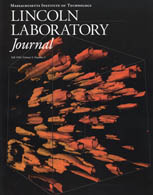Publications
Volume 5, Number 3
 |
|
The TRADEX Multitarget Tracker The Multitarget Tracker (MTT) is a real-time signal processing and data processing system installed in the TRADEX radar at the Kiernan Reentry Measurements Site (KREMS) on Kwajalein Atoll in the Marshall Islands. The TRADEX radar is a high-power, high-sensitivity instrumentation radar that was originally designed to track and gather signature data on a single target. The MTT is designed to detect and track as many as 63 targets within the beam of the radar. It provides data necessary for determining the angular locations and ranges of all of these targets, as well as signature data necessary for target identification. The TRADEX MTT is unique because it utilizes a large, mechanically steered, pencil-beam antenna, whereas other MTT systems generally rely on electronically steered antennas or rotating antenna platforms. The MTT system automatically processes received signals, reports targets, initiates and maintains target track files, and presents target information to the radar operators through real-time interactive graphical displays. This information is given to the KREMS Control Center and from there is made available to other systems in the test range. This article presents an overview of the TRADEX MTT system and discusses its implementation, application, and operation. The NOMAC and Rake Systems In the 1950s, Lincoln Laboratory developed the spread-spectrum Noise Modulation and Correlation (NOMAC) system for improved high-frequency radio communications. The production version of NOMAC, named the F9C, generated a pseudonoise (PN) sequence at the receiving terminal in synchronism with the PN modulation of the transmitted signal. The F9C achieved as much as 17 dB of jamming protection. Obtaining an additional 6 dB of protection (the original NOMAC design had promised 23 dB) required addressing the effects of multipath propagation. Lincoln Laboratory solved the multipath problem by adding a Rake receiver to the NOMAC system. The Rake receiver synthesized an adaptive matched filter corresponding to the collection of linear propagation paths that produced the actual received signal. The insights that led to Rake ultimately found application to sonar problems, the analysis of seismic signals, the radar mapping of the moon and nearby planets, and the radar imaging of orbiting satellites. Advanced Techniques for Target Discrimination Using Laser Speckle A new high-resolution imaging technique known as wavelength decorrelation is demonstrated in the laboratory for measuring target shape and estimating surface-scattering properties. In these demonstrations, the target is flood illuminated with a frequency-scanning Ti:sapphire ring laser. As the laser frequency changes, the speckle pattern in the backscattered light appears to boil; the time-varying intensity at a point in this pattern carries information about the target's range-resolved laser radar cross section U(z). A range resolution of better than 1 mm is demonstrated. A theoretical analysis of wavelength decorre1ation is also presented, including the mathematical framework for predicting wavelength-decorrelation signatures. An additional technique known as speckle tracking is described for measuring a target's angular dynamics. Super-Resolution Methods for Wideband Radar Lincoln Laboratory has investigated two concepts for improving the resolution of wideband coherent radar data. The first concept uses modern spectral-analysis methods for improving resolution relative to the restrictions of conventional Fourier processing. These spectral methods extrapolate signals in a radar frequency dimension by a process called bandwidth extrapolation (BWE). The methods can also be used for signals collected over limited time intervals. The second concept uses image signal processing models that correspond to rotating point motion. The models allow extended coherent processing (ECP) over wider target rotation angles, resulting in improved Doppler (cross-range) resolution. For sufficiently large rotation angles and for constant-amplitude scattering centers, ECP also improves the range resolution. This article discusses BWE and ECP theory and methods, and presents examples from simulations and model measurement data. Also included is a discussion of the expected precision of BWE-enhanced resolution and its dependence on the signal-to-noise ratio. |
|